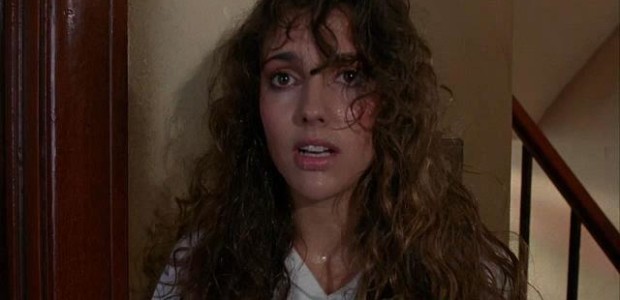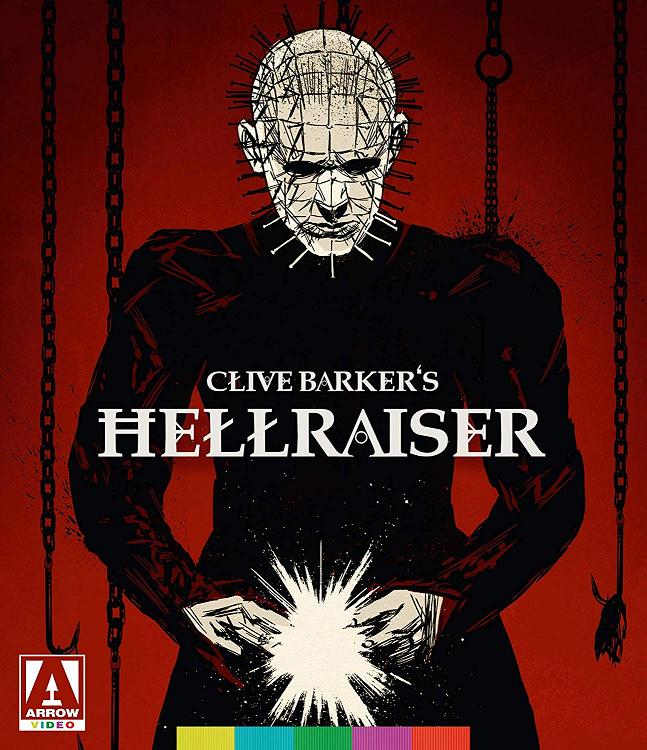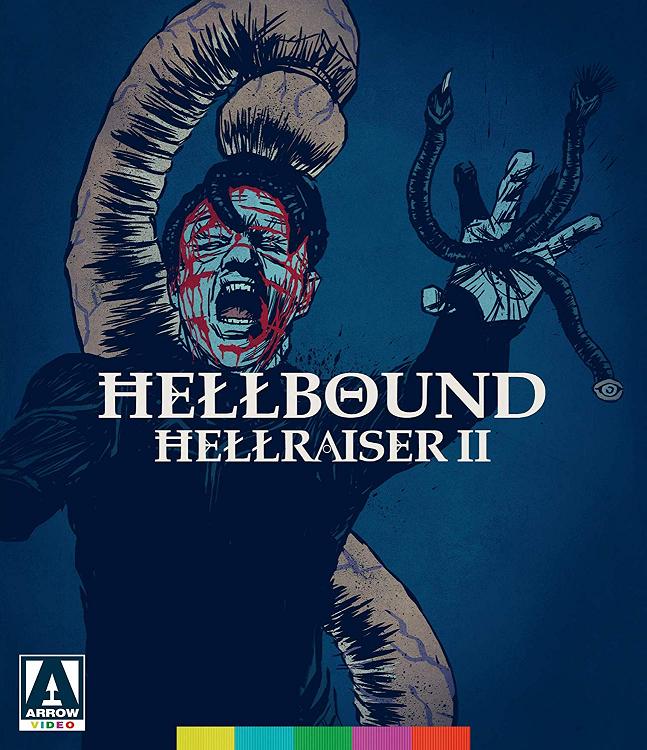HELLRAISER, at its start, seemed like the least likely horror film to spawn a franchise for many reasons — the first of those being the extremely odd and daring subject matter. Though HELLRAISER was released in the ‘80s – the very decade that saw the first installments in what would become major horror franchises – HELLRAISER wasn’t simply about a maniac with an unforgettable appearance mowing down the innocent. HALLOWEEN, though made in 1978, officially became a franchise in 1981 when its sequel was released; many would argue that, though it was not the first official slasher film ever made, it was the first that would kick-start the genre and inspire a storm of imitators, which directly led to the creation of the FRIDAY THE 13th franchise. But whether you’re talking about a legitimately classy film like HALLOWEEN, or a slice of popcorn escapism like FRIDAY THE 13th, neither film would be fairly labeled as complex. Their concepts could be broken down into one sentence.
HELLRAISER‘s couldn’t. Because HELLRAISER was sicker, slimier, angrier, and more depraved. On its surface it was about a mysterious puzzle box that had the power to open the gates of hell and allow demons (to some, angels to others) to emerge. But below that it was about sexual depravity, about the limits one kind of individual wanted to reach. It was about finding that straddling line between pain and pleasure. And honestly, it introduced certain taboos into the mainstream (well, the semi-mainstream) that had never been discussed in such a public way. Unless you had read director Clive Barker’s writing at that point. The mastermind behind “The Hellbound Heart,” which was later fleshed out into the screenplay for HELLRAISER, had been having that discussion for years.
Following the groundbreaking original film, eight sequels (!) would eventually follow, more and more shifting Pinhead – originally just one of many demons (called Cenobites) who was never intended to be the focal point – into the limelight. And, as was usually the case, his character would appear in each subsequently diminishing entry, soon becoming DTV franchise fodder like PUPPETMASTER and the CORN kids. Like many other horror franchises, how they play out in their latter entries seldom resemble how they looked in their earliest days. In the first HELLRAISER, Pinhead appears fleetingly – not the main antagonist, but a monster whom one must face when seeking the ultimate pleasure. By the final entry (at least the final one with Bradley), Pinhead had become a ghost haunting a website (or something) and swinging machetes into teens’ necks, cutting their heads off with a snarl. (Seriously.) He became the very thing Barker hadn’t intended, as Pinhead’s introduction into pop culture grouped his HELLRAISER in with all the other horror properties…where it didn’t belong.
Say, speaking of beginnings…
Made with a very low budget, HELLRAISER was the horror film no one was expecting. By the time its release year of 1987 rolled around, the FRIDAY THE 13th franchise was already on its seventh entry; HALLOWEEN and A NIGHTMARE ON ELM STREET, their fifth. And already their concepts were starting to wear thin. Clive Barker, after having had no success with a handful of short experimental films based on his own short stories, wrote and directed the ’87 horror cheapie about a shaky marriage with a history of familial infidelity and a desire for a new beginning, both shaken by the reappearance of a familiar face. (Well, kind of.) Not at all your typical ’80s horror (despite the hero being a plucky teen girl, played by Ashley Laurence), HELLRAISER was about the limits of desire, the consequences of self-destructive behavior, and the lengths one will go for what they perceive to be love. The faces remain the same in HELLRAISER, but the real faces behind them often change. Larry Cotton (DIRTY HARRY’s Andrew Robinson) and his wife Julia (Clare Higgins) have moved back to Larry’s old family home (never given a specific location, but one which was originally meant to be London). It’s the same house that bore witness to the former immediate scene of Larry’s brother, Frank (Sean Chapman) having opened the puzzle box and being ripped apart by the Cenobites for his troubles. It’s there, following a bit of unexplained bloody voodoo, that Frank is resurrected as a slimy skinless humanoid, whom Julia discovers living in the attic. Being that Frank and Julia had engaged in a bit of coitus prior to her wedding to Larry, she still desires him (either emotionally or sexually), so when Frank orders her to bring him blood by any means necessary in an effort to continue reforming his body, Julia agrees. But it’s when Larry’s daughter, Kirsty (Laurence) comes to visit that Julie and Frank’s scheme gets a little complicated.
It goes without saying that the first HELLRAISER is the best in the series, though many fans would point to its immediate sequel, HELLBOUND: HELLRAISER II, as the superior entry (more on that in a bit). Celebrated for its inventive practical effects in the same way as John Carpenter’s THE THING, HELLRAISER plays out like a doomed romance, with Julia becoming a murderess to reform Frank in hopes that they would again be together. In spite of all the grime and grit and spilled blood, it’s actually a sad story – a Greek tragedy that unfolds with equal levels Shakespearean drama and EC Comics irony. And yes, despite the original intention for Julia to actually be seen as the main villain and the takeaway face of HELLRAISER, it would be Doug Bradley as Pinhead who would inadvertently walk away with the final association with the HELLRAISER brand. His impressive appearance, along with fellow Cenobites Chatterer, Butterball, and “Female Cenobite” (she got the short stick in the names department), though limited to roughly ten minutes, would be powerful and effective enough to not only spawn a franchise but inherit the mantle of the main villain going forward.
Call it the return of New World Pictures as financier, or the short amount of time between films, or the returning of much of the creative force (sans Clive Barker, who only provided a rough outline of the story), HELLBOUND: HELLRAISER II feels like not just a natural sequel, but the second half of the overall HELLRAISER story. Following Uncle Frank and Julia’s comeuppance, Kirsty, understandably, now finds herself a patient at the Channard Institute for the mentally ill as police try to piece together what exactly happened in that house. The problem is Dr. Channard (Kenneth Cranham), who it seems harbors the same blood-thirsty need for the next level of passion-meets-pain, and who has been researching the puzzle box for years (and who seriously looks like Old Tom Hardy). In one of the most uncomfortable scenes to ever appear in a horror film, which sees a mentally ill patient slicing himself with a straight razor to kill the bugs he believes are crawling all over him, his torrential blood flow leaks onto the stolen mattress on which Julia had perished in the previous film, resurrecting her, and she becomes Channard’s guide directly into the pits of hell. Meanwhile, Kirsty does stuff involving a mute girl at the hospital who just so happens to really enjoy puzzles and for their troubles they also end up in hell.
Aesthetically, HELLBOUND: HELLRAISER II really does play out like a natural second half, but in doing so also becomes somewhat lost in its own story. Unsure of what it wants to be, it sacrifices some of its sexual daringness in favor of focusing much of its journey on its descent into hell, where Kirsty believes her father to be, and who’s in need of rescue following a dream in which he appeared to her in skinless form, scrawling bloodily on the wall, “I AM IN HELL HELP ME.” Julia (a returning Clare Higgins) is certainly sexier and more diabolical, but compared to the conflicted iteration of herself in the first film, she comes off less interesting. Once she’s reborn and her skinless ass groped by Dr. Channard, she’s given absolutely nothing to do except walk around and grin big.
By this time it had become apparent that Doug Bradley’s Pinhead was the star, and though his screen time in the makeup isn’t necessarily increased, his character is fleshed out, being ret-conned as a former British soldier during the first World War who opens the puzzle box and subsequently becomes the pointy-faced demon we all know and love. HELLBOUND: HELLRAISER II boasts some interesting and impressive visuals from first-time director Tony Randel, taking over for Barker, but also a few asinine “twists” – such as “Satan” being a gigantic puzzle box which shoots lasers, or — my favorite — Frank revealing himself as the one who appeared to Kirsty and wrote her the bloody note, all in an effort to lure her into hell so they could bang.
This was Frank’s big idea.
Way to go Frank.
Both flicks look great in this newest HD iteration, though between them, HELLBOUND: HELLRAISER II is definitely the victor, as it offers a more attractive picture than Barker’s slightly blown out original. (This becomes most apparent during HELLBOUND: HELLRAISER II, which utilizes several scenes lifted from the previous film.) The first two films boast excellent clarity, however, and the grain field never becomes too overwhelming. The first HELLRAISER is lit almost like a neo-noir film, utilizing lots of shadows and light filtering in through broken walls.
The flick match each other in terms of clear and well-presented dialogue, as well as the usual grit and grime associated with HELLRAISER bloodletting. The musical score by Christopher Young sounds great on the first, but excellent on the second, allowing his masterpiece of deranged carnival music and gothic organs to echo through the literal caverns of Hell.
On the vintage featurette Hellraiser: Resurrection, Clive Barker begins the proceedings by saying, “This is the last time I’m going to talk about this son-of-a-bitch movie,” which I guess then explains Barker’s absence from the newer HELLRAISER exploratory projects included on this release, mostly the feature-length two-part Leviathan documentaries which appear on the first two discs, and which explore the first two entries in the saga. Leviathan stands way out from all the other supplements as being the definitive exploration of the two most well-regarded HELLRAISER entries. The first part clocks in at 90 minutes, but the second runs a staggering two hours, and covers mostly every bit about the making of the films you could ever want. Barker and Ashley Laurence are missing in action, but everyone else involved in major capacities in the the first two films are present to share their memories. One thing you’re certain to come away from the Leviathan features is that screenwriter Peter Atkins is the most likable man alive. (One minor criticism: the rejected musical score by Coil is discussed, and even though composer Christopher Young appears, his two scores seem to go under-discussed.)
The remaining supplements are a combination of existing featurettes and ones newly produced by Arrow for this release. Many supplements on the previous Anchor Bay Blu-ray are sadly missing in action, though I imagine most of them were covered one way or the other in Leviathan.
The complete list of special features is as follows:
HELLRAISER
- Brand new 2K restoration approved by director of photography Robin Vidgeon
- Audio commentary with writer/director Clive Barker
- Audio commentary with Barker and actress Ashley Laurence
- Leviathan: The Story of HELLRAISER– brand new version of the definitive documentary on the making of HELLRAISER, featuring interviews with key cast and crew members
- Being Frank: Sean Chapman on HELLRAISER– actor Sean Chapman talks candidly about playing the character of Frank Cotton in Barker’s original
- Soundtrack Hell: The Story of the Abandoned Coil Score– Coil member Stephen Thrower on the HELLRAISER score that almost was
- HELLRAISER: Resurrection– vintage featurette including interviews with Clive Barker, actors Doug Bradley and Ashley Laurence, special make-up effects artist Bob Keen and others
- Under the Skin: Doug Bradley on HELLRAISER
- Original EPK featuring on-set interviews with cast and crew
- Draft Screenplays [BD-ROM content]
- Trailers and TV Spots
- Image Gallery
HELLBOUND: HELLRAISER II
- Brand new 2K restoration approved by director of photography Robin Vidgeon
- Audio Commentary with director Tony Randel and writer Peter Atkins
- Audio Commentary with Randel, Atkins and actress Ashley Laurence
- Leviathan: The Story of HELLBOUND: HELLRAISER II– brand new version of the definitive documentary on the making of HELLBOUND: HELLRAISER II, featuring interviews with key cast and crew members
- Being Frank: Sean Chapman on HELLBOUND– actor Sean Chapman talks about reprising the role of Frank Cotton in the first HELLRAISER sequel
- Surgeon Scene– the home video world premiere of this legendary, never before-seen excised sequence from HELLBOUND, sourced from a VHS workprint
- Lost in the Labyrinth– vintage featurette including interviews with Barker, Randel, Keen, Atkins and others
Under the Skin: Doug Bradley on HELLBOUND: HELLRAISER II - On-set interview with Clive Barker
- On-set interviews with cast and crew
- Behind-the-Scenes Footage
- Rare and unseen storyboards
- Draft Screenplay [BD-ROM content]
- Trailers and TV Spots
- Image Gallery
Arrow initially released these titles, along with the terrible sequel, HELLRAISER III: HELL ON EARTH, a few years ago in the Scarlet Box set, which is now out of print. The contents of the discs receiving their individual releases (though not HELLRAISER III for some reason, though it could do with the controversial aspect ratio botching) are identical to how they appeared in that limited edition set. The attention paid to the first two films alone blow any previous releases, in any region, entirely out of the water. Hardcore fans of the series likely already have the set, but if they were holding out on a more economical release, they’re in luck.
Tags: Ashley Laurence, Blu-ray, Christopher Young, Clare Higgins, clive barker, Doug Bradley, Hellbound: Hellraiser II, Horror, Kenneth Cranham, Peter Atkins, Robin Vidgeon, Sean Chapman, Tony Randel




No Comments